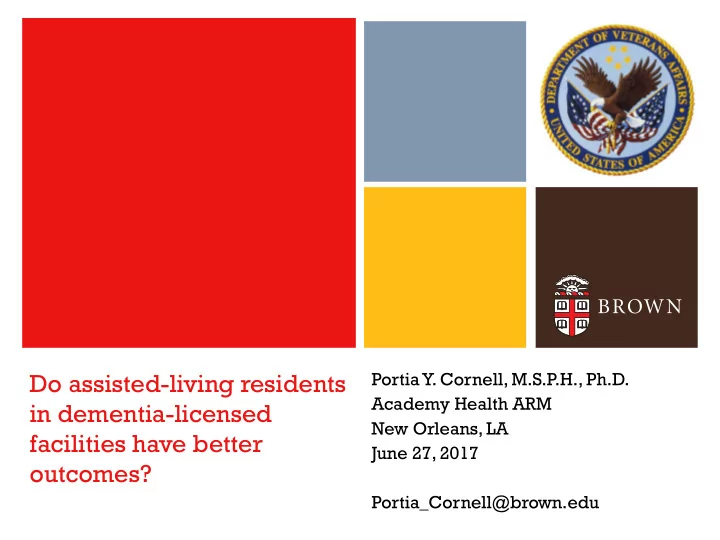

Do assisted-living residents Portia Y. Cornell, M.S.P.H., Ph.D. Academy Health ARM in dementia-licensed New Orleans, LA facilities have better June 27, 2017 outcomes? Portia_Cornell@brown.edu
Specialized dementia-care units: licensing requirements Some states issue special license for dementia care Licensing requirements differ by state Secured to prevent wandering Training requirements Staff-to-resident ratios 2
Conceptual model for specialized- care licensing Information asymmetries between prospective resident and assisted-living community Dementia-specialized- care license is a “signal” of underlying capacity and quality of a facility (Spence 1971) Key insight: cost of licensure is lower for higher-quality facilities Limitation: prospective don’t update their beliefs from experience 3
Conceptual model: information asymmetries Prospective resident AL Community Informatio n Observation • • Reputation Licensing • Licensing requirements directly impact patient outcomes License is a signal of deeper specialization & capacity 4
What is the effect of living in a dementia-specialized AL? Does living in a dementia-specialized assisted-living facility, compared to a non-specialized facility, affect resident outcomes and health care use? Outcomes: Mortality Hospice use Emergency department visits Inpatient hospital days 5
Approach Linear model effect of residing in dementia-licensed AL Instrumental variable analysis Stratify by dual status and state 6
Instrument definition Log-distance difference: D1 = distance to nearest non-specialized AL community D2 = distance to nearest dementia-specialized AL community lnDD = ln(D1) – ln(D2) Regular assisted-living Dementia-licensed residence assisted-living residence With increasing lnDD, more likely to move to a dementia- licensed residence D1 D2 D1 D2 lnDD<0 lnDD>0 7
Sample Medicare fee-for-service beneficiaries with validated residence in an assisted-living community in 2014 in the study states: Alabama, Colorado, Mississippi, New York Diagnosis of dementia in 2011, 2012, or 2013 Previous residence in 2011 or 2012 NOT in assisted living community State N Pct AL 498 8.71 CO 1,027 17.95 MS 283 4.95 NY 3,912 68.39 Total 5,720 8
Summary statistics Non-dementia- Dementia- licensed licensed Total Age 80.56 83.90 81.24 Female 68% 70% 69% Race=Black 8% 3% 7% Race=Other non-white 3% 1% 2% Dual Medicare/Medicaid 43% 14% 37% Inpatient days 2.49 1.11 2.21 Skilled nursing days 12.22 7.97 11.36 ED visits 1.01 0.63 0.93 Heart problems 63% 59% 62% Stroke/TIA 11% 11% 11% Kidney disease 29% 25% 29% Hip fracture 5% 5% 5% County: pct in poverty 15.60 14.19 15.32 9 County: median hh income 57026 60562 57740
Instrument strength Probability of dementia-licensed AL increases with instrument F-statistics >10 10
Covariate Balance Standardized Difference Change from Treatment to Instrument median_hh_inc poverty_pct hipfracture kidney stroke heart er_visits snf_days inpatient_days oth_race black female Age>=80 Age<80 Age<70 Age<60 -0.30 -0.20 -0.10 0.00 0.10 0.20 0.30 Duals Instrument Duals Treatment Non-duals Instrument Non-duals Treatment 11
Outcomes Mean outcomes among study sample Duals(N=2114) Non-Duals (N=3606) Mortality (died in 2013) 0.14 0.13 Hospice (any) 0.06 0.08 Emergency Dept Visits† 0.10 0.09 Hospital Inpatient Days† 0.23 0.11 Skilled Nursing Days† 1.25 1.24 † Adjusted for observed months 12
Main Results: IV Estimates Effect of living in a dementia-specialized assisted-living residence compared to non-specialized Duals Non-Duals (N=2114) (N=3606) Mortality (died in 2013) 0.35*** 0.04 Hospice (any) 0.28*** 0.07** Emergency Dept Visits† 0.06 0.01 Hospital Inpatient Days† 0.34 0.09 Skilled Nursing Days† 0.29 -0.10 *p<0.10, **p<0.05, ***p<0.01 † Adjusted for observed months 13
IV vs. OLS results: mortality (duals) 14
IV vs. OLS results: mortality (non-duals) 15
IV vs. OLS results: hospice (duals) 16
IV vs. OLS results: hospice (non-duals) 17
Interpreting Results Dementia-specialized communities increase mortality? Inefficient allocation of resources Value independence and quality of life over safety and prolonging life? Increase use of Medicare hospice benefit suggests different priorities Geographic differences? E.g.: frail individuals may choose assisted living over a nursing-home special-care-unit if there is a dementia-specialized facility nearby 18
Caveats, limitations, and hedges IV addresses patient-level selection, but NOT geographic selection Within a dementia-licensed community with both specialized and non-specialized care, cannot identify who lives in the dementia unit 19
Thank You! Kali S. Thomas & Momotazur Rahman, co-authors National Institute on Aging grant (R21 AG047303; PI, K.S. Thomas) Veterans Administration OAA Advanced Fellowship Contact: Portia_Cornell@brown.edu 20
Selected References Carder P, O’Keeffe J, O’Keeffe C. Compendium of Residential Care and Assisted Living Regulations and Policy: 2015 Edition. 2015. Prepared by RTI International for the Office of Disability, Aging, and Long-Term Care Policy, Office of the Assistant Secretary for Planning and Evaluation, U.S. Department of Health and Human Services. Harris-Kojetin L, Sengupta M, Park-Lee E, et al. 2016. Long-term care providers and service users in the United States: Data from the National Study of Long-term Care Providers, 2013-14. National Center for Health Statistics. Vital Health Stat 3(38). Spence M. 1973. Job Market Signaling. Quarterly Journal of Economics 87(3):355-374. Thomas K, Dosa D, Gozalo PL, Grabowski DC, Nazareno J, Makineni R, Mor V . A methodology to Identify a Cohort of Medicare Beneficiaries Residing in Large Assisted Living Facilities Using Administrative Data 21
Instrument balance: propensity score Dementia-licensed assisted living propensity score vs. lnDD AL CO .4 .4 .2 .2 0 0 -6 -4 -2 0 2 -6 -4 -2 0 2 4 MS NY .4 .4 .2 .2 0 0 -5 0 5 -6 -4 -2 0 2 4 Propensity to move to dementia-specialized AL 95% CI Smoothed average
Main Results: IV Estimates Effect of living in a dementia-specialized assisted-living residence compared to non-specialized Duals Non-Duals (N=2114) Pct mean (N=3606) Pct mean Mortality (died in 2013) 0.35*** 250% 0.04 34% Hospice (any) 0.28*** 496% 0.07** 85% Emergency Dept Visits† 0.06 57% 0.01 10% Hospital Inpatient Days† 0.34 150% 0.09 78% Skilled Nursing Days† 0.29 23% -0.10 -8% *p<0.10, **p<0.05, ***p<0.01 † Adjusted for observed months 23
Recommend
More recommend